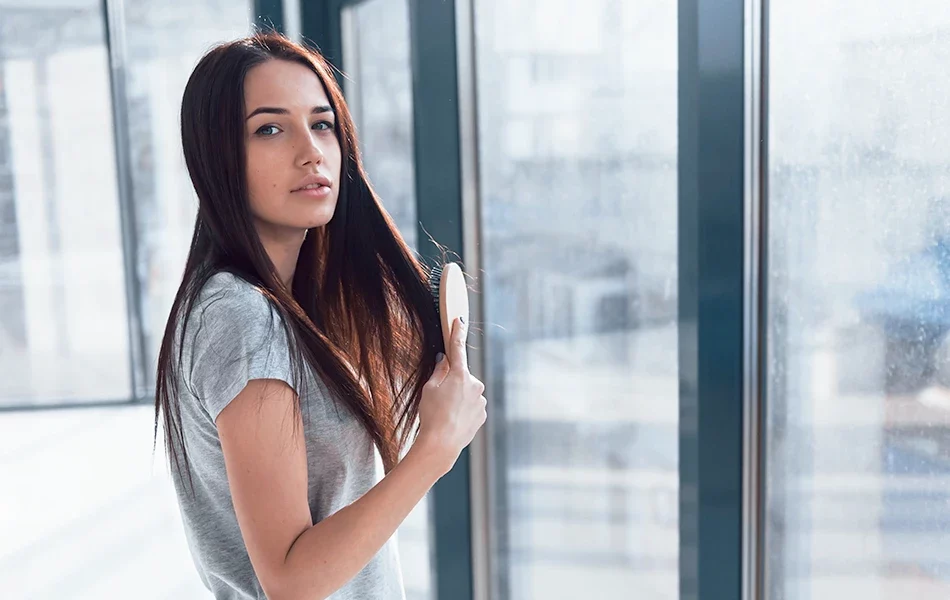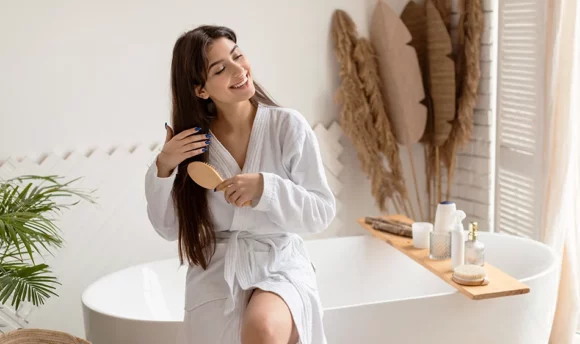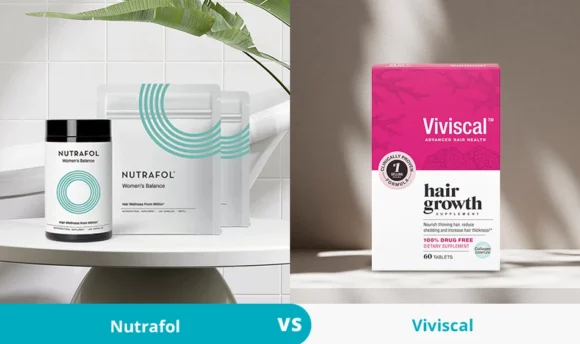Type 1a Hair (Straight): Tips on How to Take Care of and Style It
Whether you have straight, curly, or wavy hair, knowing your hair type is essential to understand how to properly care for your locks. Find out if you have type 1a hair and what products to use to manage it.

No matter how unique your style is, every hair type falls into a certain pattern category. Each category has its pros and cons, all of which require different products and styling techniques to keep them healthy.
If your hair is straight, sleek, and frizz-free, it’s likely that you have type 1a hair. While this may seem easier to manage than those with tight curls, you’ll find that smooth, fine strands can be just as difficult to control.
Find out if you have type 1a hair, the best ways to style it, and how to properly care for your strands.
What Is Type 1a Hair?
Those who are in the type 1a category have extremely straight, fine hair. Although they don’t have any waves or curl patterns, type 1a strands tend to be shiny and smooth, giving the hair an overall sleek appearance. It’s one of the rarest hair types as well.
The outermost cuticle layer of type 1a hair is dense and broad, which contributes to its silkiness. However, straight strands can often appear flat as they lack the volume and thickness of other kinds of type 1 hair.
This is because the natural sebum oils that are produced by glands on the scalp can easily travel down the straight hair shaft. Although the buildup of these oils can weigh hair down, this also helps to give type 1a locks a glossy, well-hydrated shine.
Pros of Type 1a Hair
Though pin-straight hair textures can be difficult to style, there are some major benefits to type 1a hair, which are determined by genetics. Read on to discover what they are and why your silky smooth locks are often the envy of people with other hair types.
#1 Hair retains moisture
One of the main characteristics of type 1a hair is its poker-straight strands. Oils produced at the roots are, therefore, able to slide down the lengths much more easily, keeping your hair moisturized and nourished at all times.
#2 Remains frizz-free
Unlike hair that is more curly or wavy, type 1a curls stay frizz-free through rain and shine. Frizz occurs when your strands lack moisture and absorb it from the surrounding air. This isn’t a problem if you have type 1a hair.
#3 Glossy hair
By allowing the scalp’s natural oils to penetrate the hair shaft, straight strands appear shinier, with a natural shine and silky smooth texture that often causes envy.
Cons of Type 1a Hair
All hairstyles have their pros and cons, including type 1a hair. But don’t let that get you down because, with the right tools and techniques, they can be easily managed.
#1 Oily roots
Although a completely straight hair type helps oils travel down the shaft and keep it moisturized, it can also be a drawback.
It causes your roots to become too oily and look greasy, contributing to the limp look.
#2 Lacks volume
Since fine hair is already quite flat, adding heavy styling products to it makes it even heavier, making it difficult to add any kind of volume to type 1a hair.
#3 Doesn’t hold a curl
Having little to no volume can be a problem when trying to use heat styling tools, as the thin strands struggle to hold curls. This also makes straight hair types more fragile, putting them at a higher risk of breakage or shedding.
How to Take Care of Type 1a Hair
Once you’ve figured out whether or not you have type 1a hair, you need to know how to properly care for it to maintain that signature shine.
Luckily, type 1a hair is pretty easy to maintain because it is pin-straight, but be careful not to overload it with products.
Here are some do’s and don’ts when it comes to caring for your fine locks:
#1 Don’t go to bed with wet hair
Drying your hair before bed may seem like an unnecessary task, but not doing so can leave your strands in frizzy knots when you wake up.
If you can’t avoid going to sleep with damp hair, spray your lengths with a leave-in conditioner for extra moisture and protection.
#2 Don’t use hot water on your hair
Turning up the temperature in the shower may be tempting, but hot water is a no-no for type 1a hair. This is because heat encourages the scalp to produce more oil, making your hair greasier and flatter.
Using cold water is a much better technique because it helps remove oil and reduces the frequency of shampooing.
#3 Don’t use too many hair products
With so many haircare products on the market, it can be tempting to spend all of your hard-earned dollars. However, to save your bank balance and your hair, try to avoid overusing products.
Those with type 1a hair often struggle with limp and lifeless curls, as well as unruly flyaways that are too difficult to tame.
These problems can be exaggerated by product buildup, so stick to a minimal amount of products that are specifically designed for thin hair.
Stay away from heavy products that can weigh hair down, and opt for lightweight hair sprays and gels, as well as volumizing shampoos and conditioners.
#4 Wash your hair regularly
As we know, type 1a hair is much more prone to greasiness than curly or coily types. To prevent this from becoming a problem, try washing your hair with shampoo and conditioner every 2–3 days.
Although oily strands can be irritating, don’t be tempted to wash them more often than necessary. Having some natural oils is important for fighting dryness, and shampooing too often can strip your hair of these oils.
This will cause the scalp to produce more oil, resulting in limp and greasy hair once again.
#5 Use conditioner
With hair that is already smooth and shiny, it can be tempting to skip the conditioning step to prevent greasy roots.
But even if your hair is shiny, it is still at risk of becoming dry and dull, especially from the mid-lengths to the ends.
Therefore, you should include conditioner in your shampooing routine to ensure that your lengths stay moisturized and retain the softness that type 1a hair is known for.
#7 Blow your hair upside down
If you’re looking for a little more volume in your flat type 1a strands, then try changing the way that you dry your hair.
Although it may sound strange, turn your head upside down and blow dry your hair in this position to encourage the strands to move away from the roots. This is one of the most effective ways to add volume to lifeless type 1a hair.
#8 Be gentle with brushing
One of the benefits of having type 1a hair compared to other thicker types is that it is easier to comb through. However, it can still become tangled, which can be irritating when it comes to brushing.
Rather than using force to break down those knots, gently brush the end of each hair strand to start the detangling process. Tugging can cause damage to your cuticles and put your delicate hair at greater risk of breaking.
Therefore, you should always take care when styling your fine locks.
#9 Get regular haircuts
Leaving your hair too long without a cut can cause it to become more weighed down, which makes it look limp and lifeless.
You should, therefore, book yourself in for regular trims to help your hair appear fuller and thicker and create the optimal conditions for faster hair growth.
Which Hairstyles Are Perfect for Type 1a Hair?
When you’ve got type 1a hair, finding a style that will give your limp locks some life can be tricky. If you’re struggling to decide, keep reading for some suggestions on the best hairstyles for your fine hair.
#1 Layered haircut
Layers help to give shape to fine hair that often hangs flat from your head. They also bring more movement and definition to your locks, as well as provide you with more styling options. For example, try tying your hair up and leave out two shorter layers at the front of your head.
#2 Blunt haircut
Going for a harsh, blunt cut is a great way of helping your strands to appear fuller. Having straight lines at the end of every hair strand creates an illusion of thickness that compliments the shine of your hair perfectly.
#3 Highlights
Putting a subtle lighter color through your lengths can really help to boost type 1a hair, which sometimes appears flat or dull. Be sure to take advice from your hair stylist to prevent your exciting new style from causing damage, and refrain from bleaching too often.
#4 Braid
If you’re looking for an everyday hairstyle that doesn’t require a cut or color, try putting your hair into a braid. From French braids to classic plaits, there are several different styles that you can attempt to give your hair a little more flair.
Braids are also ideal for covering greasy roots when you don’t want to wash your hair or on days when you don’t have time for styling.
Best Products and Ingredients for Type 1a Hair
Now that you know how to care for and style your type 1a hair, you may be wondering which ingredients and products are best for nourishing your fragile locks.
Read on to find out what to look for in a shampoo, conditioner, or styling product for thin hair.
Ingredients
The ingredients that are most beneficial for type 1a hair are natural ones that moisturize and nourish the hair without making it oily. They also help to remove product buildup to prevent hair from looking flat whilst adding some volume at the same time.
These ingredients include:
- Rice water
- Honey
- Aloe
- Keratin
- Vitamins B5, C, and E
- Coconut oil
Shampoos and other products
When it comes to selecting appropriate products for type 1a hair, you should focus on lightweight, volumizing shampoos and conditioners and styling products that help to soak up excess oil.
The Moérie products fit this description perfectly, with a range of natural ingredients that moisturize, protect, and strengthen your locks without leaving them greasy.
Here are some other great recommendations:
- Living Proof Full Volume Shampoo
- Bumble and Bumble Thickening Volume Conditioner
- Nexxus Hydra-Light Weightless Moisturizing Conditioner
- Dove Volume and Fullness Dry Shampoo
- Virtue Refresh Purifying Leave In-Conditioner
FAQs
If your hair is extremely straight, very fine, and lacking volume, you have type 1a hair. You are also likely to have this hair type if your lengths struggle to hold a curl even when heat styling tools are used and if your strands are prone to falling out.
1a and 1b hair types are quite similar as they are both straight. However, type 1b hair has a slight wave in each strand, as well as more volume. Type 1b hair can also hold a curl more effectively.
Type 1a hair is the rarest of all types, as most people with straight strands have the slightly more voluminous 1b hair type. This type of hair is found most commonly in people of Asian descent.
A Word From a Trichologist
Type 1a hair is straight, thin, and doesn’t hold any volume. When styling this sort of hair, try to use light and volumizing products to help your lengths appear thicker and fuller.
Although it’s important to choose products that are designed specifically for your hair type, you can also improve your hair health by cutting your hair regularly and eating a balanced diet.
Choose foods that contain vital vitamins and minerals to protect against further hair thinning and breakage, such as avocados, smoked salmon, eggs, and leafy greens.
Getting regular scalp massages is a great way of improving hair thickness, as this action helps to increase blood flow to the follicles.
If you’re unsure of how to properly care for type 1a hair, you should speak to a professional hair stylist. They can give you further advice on products and techniques to use, as well as ways that you can prevent your hair from looking limp and lifeless.
Conclusion
The 1a hair type is characterized by straight, fine, and flat hair. Although it lacks volume and struggles to hold a curl, people with this hair type also benefit from smooth and shiny hair strands that give you a sleek, photo-ready finish.
To maintain healthy type 1a hair, ensure that you use products sparingly and those that are specifically tailored to fine hair. Wash your hair regularly but avoid overwashing, and consider getting a proper haircut to give your locks a fuller and thicker appearance.

















































 Select your language:
Select your language: 








